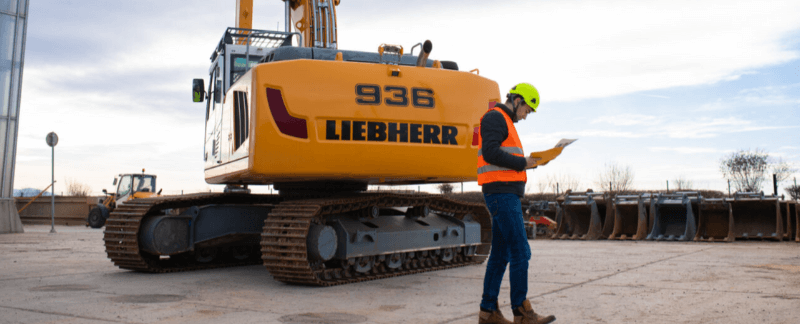Excavator Safety with AI: Preventing Worksite Accidents
Excavators are essential to construction and earthmoving operations, but their size and limited visibility pose serious risks to nearby workers. Worksite accidents remain one of the leading causes of injuries on construction sites, especially in busy or confined environments. By integrating advanced AI-powered camera systems like Blaxtair, companies can significantly improve their situational awareness and prevent collisions with pedestrians in real time.
Why Excavator Safety Demands AI Assistance
Impressive for their size, power and mobility, excavators are used for a wide variety of demanding jobs, from earthmoving and quarrying to demolition, foundation digging and material handling. On many of these sites, the presence of ground workers is unavoidable, whether for manual sorting of waste, managing pipes and cables, or assisting with driver guidance.
In open spaces or uneven terrain, even the best organizational safety measures, such as zone demarcation or visual markings, can quickly prove insufficient. Managing the coexistence of machines and pedestrians becomes difficult, especially when operations are moving quickly, deadlines are tight, or environmental constraints come into play.
Excavators, in particular, are extremely dangerous for anyone who enters their operating range. Not only do they present multiple rear and side blind spots that obstruct the operator’s vision, but they also offer 360-degrees rotation, meaning a collision can occur even when the machine is stationary.
According to the U.S. Bureau of Labor Statistics, hundreds of serious injuries and fatalities occur each year as a result of collisions with heavy machinery, often related to blind spots. These risks require much more than traditional rearview mirrors and human vigilance. They require intelligent, always-on systems capable of detecting pedestrians and alerting in real time, without delay or distraction.

Understanding Potential Hazards in Excavators
Rear & Side Obstruction Issues
The structural design of excavators naturally limits visibility in several areas. The rear engine compartment, counterweights and boom arms limit the operator’s field of view, creating large blind zones that can easily hide a person, tool cart, or even another vehicle.
When workers walk behind or alongside the machine, whether guiding it, performing tasks, or simply crossing it, they can be completely invisible to the operator. A rotating upper frame or sudden maneuver then poses a serious hazard.
Limited Operator Visibility
Despite improvements in cab ergonomics and visibility aids, excavator operators still rely heavily on rearview mirrors and human vigilance. However, the stress of the job, long hours, and complex site layouts make it easy to overlook a person or movement, especially when multiple tasks are being managed simultaneously.
AI systems are designed to compensate for this human limitation, seeing where the operator cannot see and reacting within milliseconds.
Dynamic, Unpredictable Environments
Excavator work rarely takes place in clean and predictable conditions. Sites are constantly evolving, with new equipment, moving materials, and changing pedestrian patterns. Safety protocols that are effective one day may fail the next, particularly in the event of weather, noise, or an emergency.
In these contexts, static safety solutions are insufficient. Dynamic, real-time awareness is required, precisely what AI-based pedestrian detection provides.
AI Vision Systems for Excavator Safety
Modern AI vision systems, like those developed by Blaxtair, are designed specifically to eliminate these blind spot risks. Using advanced neural networks and proprietary datasets, Blaxtair systems can identify pedestrians in real time and distinguish them from other obstacles.
This distinction is crucial: while traditional sensors or proximity alarms can be triggered by any object, Blaxtair is trained to recognize human shapes, reducing false alarms and ensuring reliable and relevant alerts.
Real-time alerts to operator only when needed
The system continuously monitors the machine’s surroundings. When a pedestrian enters a danger area, the operator receives an instant visual and audible alert, allowing them to intervene immediately. When no one is present, no alert is triggered, allowing operators to stay focused and reduce fatigue.
This smart filtering allows operators to trust the system without feeling overwhelmed or distracted.
360° Coverage for Maximum Safety
Blaxtair can be configured to provide full 360-degree detection around the excavator, ensuring that no pedestrian is left behind, even when approaching from behind or from the side. This complete coverage is particularly essential for excavators, which are capable of rotating on the spot, making any surrounding area potentially dangerous. With Blaxtair, operators have a complete view of their surroundings, drastically reducing the risk of collisions.
Heatmaps
Beyond direct detection, Blaxtair also generates heatmaps highlighting the most dangerous areas of the site, those where pedestrian and vehicle interactions are highest. These insights helps safety managers redesign workflows, isolate high-risk areas, and take proactive measures to prevent accidents.

ROI & Safety Impact in Real Worksites
Adding AI to excavators doesn’t just make sites safer, it also offers measurable business benefits. In sectors like public infrastructure, demolition, urban construction, or quarrying, the stakes are high, and even a minor accident can lead to costly delays or lawsuits.
Contractors using Blaxtair have reported:
- A significant reduction in near-misses involving pedestrians
- Improved operator focus and peace of mind
- Less downtime
- Insurance savings through reduced claims and more complete documentation
- Seamless integration with fleet management and telemetry systems
When AI cameras are connected to a centralized dashboard, safety managers can track events, monitor compliance, and even anticipate risk areas before an incident occurs.
Industry Standards & Safety Compliance
In the United States and Europe, regulatory bodies are paying increased attention to pedestrian detection technologies.
In the United States, OSHA requires employers eliminate or reduce hazards involving moving equipment. AI pedestrian detection systems directly address this requirement, adding a proactive layer of protection.
In the EU, updated guidelines under the Machinery Directive and EN ISO standards recognize intelligent systems as valid and effective safety measures.
Contractors using Blaxtair are also better positioned during insurance audits, thanks to the recording of detection events and visual records that provide solid evidence of risk management procedures.

Case Study: AI Success on a Mid-Sized Excavation Site
Contractors who have equipped their excavator fleets with Blaxtair AI pedestrian detection systems report significant safety improvements and operational benefits across various types of sites, from construction and demolition to public infrastructure.
By helping to eliminate accident risks, these AI systems contribute to a stronger safety culture and more efficient site operations. Many companies have also seen reduced safety-related downtime, improved audit compliance, and fewer incident-related work stoppages, all of which have a direct impact on project delivery times and insurance risks.
In several deployments, no accidents or injuries have been recorded for extended periods, confirming the effectiveness of AI-based detection in preventing collisions between machines and pedestrians on active construction sites.
According to an independent industry report, AI-powered pedestrian detection systems implemented in heavy machinery environments typically achieve a 60–85% reduction in pedestrian-vehicle near-miss incidents within the first year.
Conclusions
Preventing excavator accidents isn’t just a moral and legal imperative, it’s also a wise investment. With AI-powered vision systems like Blaxtair, contractors can improve safety and productivity, reduce costs, and provide peace of mind to workers and site managers.
FAQs
How can AI cameras reduce accidents with excavators on U.S. sites?
AI vision systems like Blaxtair detect pedestrians in real time, even in excavator blind spots. This helps prevent rear-end and side-impact collisions, which are common on US construction and demolition sites where workers’ visibility is limited.
Are AI safety systems like Blaxtair compliant with U.S. construction safety regulations?
Yes, Blaxtair contributes to OSHA compliance in the U.S. by enhancing pedestrian detection around heavy equipment, helping to reduce liability and meet workplace safety audit requirements.
Is it worth adding AI vision systems to mid-sized excavator fleets in the U.S.?
Absolutely. U.S. contractors report fewer incidents and better ROI after installing AI cameras like Blaxtair, thanks to fewer accidents, less downtime, and better operator awareness on active sites.
Ready to integrate AI into your site? Schedule a free Blaxtair demo or request a site safety risk assessment today.
